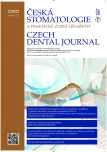ATTITUDES OF CZECH DENTAL CHAMBER MEMBERS TO THE COVID-19 PANDEMIC MEASURES IMPLEMENTED IN DENTAL PRACTICES
Authors:
V. Peřina 1; R. Šmucler 2; J. Treglerová 1; N. Pilbauerová 3; M. Kunderová 3; J. Schmidt 3,*; Autor Korespondující *
Authors‘ workplace:
Klinika ústní, čelistní a obličejové chirurgie, Masarykova univerzita, Lékařská fakulta a Fakultní nemocnice Brno
1; Stomatologická klinika, Univerzita Karlova, 1. lékařská fakulta a Všeobecná fakultní nemocnice v Praze
2; Stomatologická klinika, Univerzita Karlova, Lékařská fakulta v Hradci Králové a Fakultní nemocnice Hradec Králové
3
Published in:
Česká stomatologie / Praktické zubní lékařství, ročník 122, 2022, 2, s. 33-42
Category:
Original articles
doi:
https://doi.org/10.51479/cspzl.2022.009
Overview
Introduction, aim: This work describes the attitudes of Czech Dental Chamber members to anti-epidemic measures during the COVID-19 pandemic. Responses are further classified according to the respondents‘ COVID-19 status.
Method: The data were obtained via an online questionnaire survey from June 23 to September 4, 2021.
Results: A total of 2716 members of the Czech Dental Chamber participated in this survey, representing 24.3% of all chamber members. Almost 90% of the respondents considered the official recommendation against the transmission of SARS-CoV-2 infection issued by the Czech Dental Chamber to be adequate, approximately 6% insufficient, and 4% too strict. The prevalence of COVID-19 in the group considering the recommendation too strict was statistically significantly higher compared to the group considering the recommendation to be adequate (p = 0.0345, odds ratio (OR) 1.592). The respondents who performed COVID-19 testing in their practices showed a statistically significantly higher percentage of detected COVID-19 infections (p < 0.0001, OR 1.883). Almost three-quarters of respondents want to maintain strict anti-epidemic measures even after the pandemic; this commitment is statistically significantly higher for the respondents who did not have COVID-19 (p = 0.0041, OR 1.511). COVID-19 infection did not affect the willingness to be vaccinated against influenza. In contrast, the respondents with a positive attitude towards vaccination against COVID-19 showed a statistically significantly higher willingness to get vaccinated against the flu (p < 0.0001, OR 10.36).
Conslusion: The prevalence of COVID-19 was statistically significantly higher among dentists who preferred less stringent measures against infection transmission. Respondents who performed COVID-19 testing in their practices showed a statistically higher percentage of detected COVID-19 infections. Almost three quarters of respondents intended to adhere to strict measures against the infection transmission even after the end of the pandemic. The will to be vaccinated against COVID-19 was significantly higher than against the flu. Respondents with a positive approach to vaccination against COVID-19 were significantly more willing to be vaccinated against influenza.
Keywords:
Dentistry – SARS-CoV-2 – COVID-19 – dentist
Sources
1. Abedin M, Islam MA, Rahman FN, et al. Willingness to vaccinate against COVID-19 among Bangladeshi adults: Understanding the strategies to optimize vaccination coverage. PLoS One. 2021; 16(4): e0250495.
2. Islam MA, Alam SS, Kundu S, et al. Prevalence of headache in patients with coronavirus disease 2019 (covid-19): a systematic review and meta-analysis of 14,275 patients. Front Neurol. 2020; 11: 1492.
3. Islam MA, Kundu S, Alam SS, et al. Prevalence and characteristics of fever in adult and paediatric patients with coronavirus disease 2019 (COVID-19): A systematic review and meta-analysis of 17 515 patients. PLoS One. 2021; 16(4): e0249788.
4. Saniasiaya J, Islam MA, Abdullah B. Prevalence and characteristics of taste disorders in cases of COVID-19: a meta-analysis of 29,349 patients. Otolaryngol Head Neck Surg. 2021; 165(1): 33–42.
5. Hu B, Huang S, Yin L. The cytokine storm and COVID-19. J Med Virol. 2021; 93(1): 250–256.
6. Li X, Ma X. Acute respiratory failure in COVID-19: is it “typical” ARDS? Crit.Care. 2020; 24(1): 198.
7. Lotfi M, Hamblin MR, Rezaei N. COVID-19: Transmission, prevention, and potential therapeutic opportunities. Clin Chim Acta. 2020; 508: 254–266.
8. Goldman E. Exaggerated risk of transmission of COVID-19 by fomites. Lancet. 2020; 20(8): 892–893.
9. Chin AWH, Chu JTS, Perera MRA, et al. Stability of SARS-CoV-2 in different environmental conditions. Lancet. 2020; 1(1): e10.
10. Huang C, Wang Y, Li X, et al. Clinical features of patients infected with 2019 novel coronavirus in Wuhan, China. Lancet. 2020; 395(10223): 497–506.
11. Cucinotta D, Vanelli M. WHO Declares COVID-19 a pandemic. Acta Biomed. 2020; 91(1): 157–160.
12. Czechia, Coronavirus Cases per Capita, June 2021: Global Change Data Lab; 2021. Dostupné z: https://ourworldindata.org/ explorers/coronavirus-data-explorer?tab=table& zoomToSelection=true&time=earliest.. 2021-06-30&facet=none&picker- Sort=asc&pickerMetric=location&hideControls=true& Metric=Confirmed+cases&Interval=Cumulative& Relative+to+Population=true&Align+outbreaks= false&country=~CZE
13. Czechia, Coronavirus Deaths per Capita, June 2021: Global Change Data Lab; 2021. Dostupné z: https://ourworldindata.org/ grapher/total-covid-cases-deaths-per-million? tab=table&time=2019-12-31..2021-06-30
14. Schmidt J, Waldova E, Balkova S, Suchanek J, Smucler R. Impact of COVID-19 on Czech dentistry: A nationwide cross-sectional preliminary study among dentists in the Czech Republic. Int J Environ Res Public Health. 2021; 18(17).
15. Schmidt J, Perina V, Treglerova J, et al. COVID-19 Prevalence among Czech dentists. Int J Environ Res Public Health. 2021; 18(23).
16. Schmidt J, Perina V, Treglerova J, et al. COVID-19 Vaccination among Czech dentists. Vaccines. 2022; 10(3).
17. Ročenka ČSK 2020. Praha: Česká stomatologická komora; 2021. Dostupné z: https://www.dent.cz/o-nas/rocenky/
18. Netquest. Netquest Sample Calculator . Dostupné z: https://www.netquest.com/en/ calculate-your-sample-size
Labels
Maxillofacial surgery Orthodontics Dental medicineArticle was published in
Czech Dental Journal

2022 Issue 2
Most read in this issue
- MOLAR INCISOR HYPOMINERALIZATION
- HYPERODONCIE
- NEOPTERIN, KYNURENIN A TRYPTOFAN JAKO MARKERY AKTIVACE IMUNITNÍHO SYSTÉMU U PARODONTITIDY
- PRAŽSKÉ DENTÁLNÍ DNY 2022 SE ZAMĚŘÍ NA SNÍMATELNOU PROTETIKU
